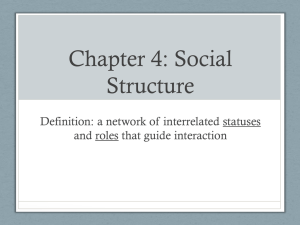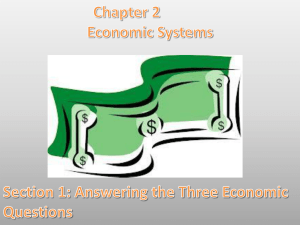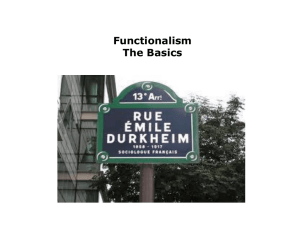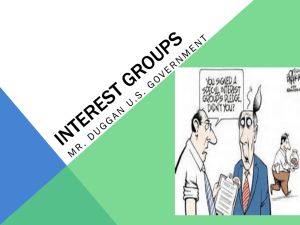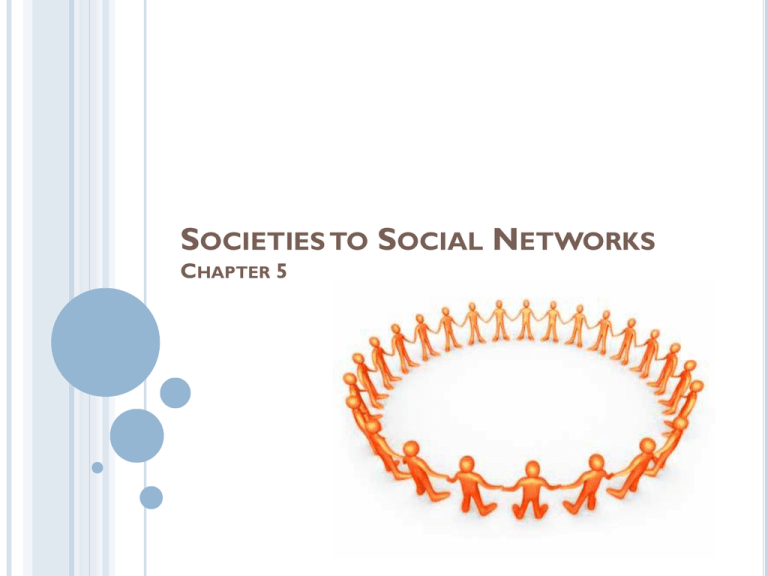
SOCIETIES TO SOCIAL NETWORKS
CHAPTER 5
SOCIETIES AND THEIR TRANSFORMATION
Groups- people who interact with
one another and who think of
themselves as belonging with each
other
Society- largest group
Consists of people that share a
culture and/or territory
Sets stage for life experiences,
influences behavior, how we see the
world
Set boundaries for our lives
Technology creates changes in society
through time
As society changes so does nature
and types of groups
SOCIETIES AND THEIR TRANSFORMATION
Hunting and Gathering Societies
Fewest social divisions
Basic social division is by sex, few other social
divisions
Groups have a shaman that can influence spiritual
forces
Major unit of organization is the family
Most group members are related by ancestry or
marriage
Family distributes food, educates children, nurses
sick, provides virtually all needs
Societies are small
Groups are nomadic
Place a high value on sharing food
Egalitarian society
They have few material possessions
No rulers, decision is reached by consensus
Most leisure of all groups
SOCIETIES AND THEIR TRANSFORMATION
Pastoral and Horticultural Societies
10,000 years ago groups found they could tame,
breed animals and cultivate plants
Developed permanent villages, organized by clans
Domestication of plants and animals first social
revolution
Dependable food supply created changes
Division of labor- specialized jobs and created a
surplus of objects and this stimulated trade
Set stage for social inequality
Led to feuds, war and slavery
Wealth and power grew more concentrated
Individuals became leaders of groups (chiefs)
More possessions led to lesser equality
Where people located within society determined what
happened to them in life
SOCIETIES AND THEIR TRANSFORMATION
Agricultural Societies
Invention of the plow made land more
productive, created food surplus, called
agricultural revolution
Development of cities, culture (art,
literature, music)
Inequality became fundamental feature of
society
Some gained control over resources, to
protect power they developed armies,
levied taxes
Conflict theory- concentration of
power and resources, oppression of
people led to rise of modern state
Females became subject to males (men
were farmers, took care of livestock left
women subsidiary tasks) when metal
became attached to plows
SOCIETIES AND THEIR TRANSFORMATION
Industrial Societies
1700’s invention of steam engine
led to Industrial Revolution
Human and animal power
replaced by machines
Social inequality grew greater
Surplus was greater, huge effect
on social life
Industrialists gained control of
means of production (land, labor,
capital)
Inequality reversed as time went
on, now industrial societies enjoy
a high standard of living and
greater equality
SOCIETIES AND THEIR TRANSFORMATION
Postindustrial (Information) Society
Fourth social revolution- Societal transformation based on
microchip technology
Basic component is information and specialized knowledge
Individuals don’t produce anything, just use information to
provide services others are willing to pay for
New technology allows us to work at home, changes
communication and consumer patterns
GROUPS WITHIN SOCIETY
In
1933 Emile Durkheim concluded to prevent
sense of not fitting (anomie) in we needed to belong
to small groups
Groups act as a buffer between individual and
society, give meaning and sense of purpose
Two terms often confused with groups- aggregate
and category
Aggregate consists of individuals that share same
physical space, but do not see themselves as
belonging together
Category- statistic, people with similar
characteristics
GROUPS WITHIN SOCIETY
Primary Groups- give basic
orientation to life
Develop early in life
A. Family our first primary group
B. Provide intimate face to face
relationships
C. Give us identity
D. Essential to our well being
E. Meets a basic human need
F. Values and attitudes become part
of our identity
G. Difficult to separate self from
primary group
GROUPS WITHIN SOCIETY
1.
2.
3.
Secondary Groups- larger and
more anonymous
Formed with a specific goal and
roles are interchangeable
Based on common interest,
more impersonal
Members interact based on
specific status
Fail to satisfy need for association,
consequently they break down
into primary groups
Primary groups serve as a buffer
between us and demands
secondary groups pale on us
GROUPS WITHIN SOCIETY
1.
2.
3.
4.
In-groups are groups we feel loyalty
to
Out- groups group toward which
one feels antagonism
Identification with group gives sense
of belonging, loyalty
Membership produces rivalries
Consequences
Membership can produce
discrimination and hatred
Identification with in-groups basis
for racial, ethnic division
View traits of in-group as virtues,
same attributes in out-group seen as
vices
Divides world into we and they
Natural part of social life
GROUPS WITHIN SOCIETY
Reference Groups
Groups we use as standards to
evaluate ourselves
Can be family, classmates, coworkers
A. Exert influence over our lives
by providing a yard stick
B. Operate as a form of social
control, give us frame of
reference for our achievements
C. We want our behavior to
measure up to the groups
standards, can lead to inner
turmoil if they do not match
SOCIAL DIVERSITY :RACE, CLASS AND GENDER
Social
diversity influences group contact, can
perpetuate social inequality
Large groups turn inward -only have contact
among themselves
Social diversity can promote separatism
Heterogeneous groups turn outwardinternally diverse groups are more likely to
interact with outsiders
Physical boundaries create social
boundaries- less likely to interact with other
people
SOCIAL NETWORKS
Large groups break down into cliques
(internal factions within groups that
interact with each other)
Form social networks (social ties
radiating outward from self that link
people together)
Technology has created a new type of
group electronic community where
members communicate about any topic
Nature of interest give them feelings of
belonging together, possibly can have an
equalizing effect on groups
Young, well educated, live in large cities
have larger social networks
Men include more business contacts in
their networks
Women include more family members in
their social networks
GROUP DYNAMICS
Group dynamics refer to interaction within groups, how they
influence us and how we affect groups
Small groups- few members, interaction with all other
members, can be primary or secondary
Group size
Dyad- smallest, two people
Most intense form of group interaction, if one member
decides not to participate, group collapses
Triad- three people, addition of third person alters group
Interaction between first two decreases and can create strain
Stronger and more stable than dyads
Tend to form coalitions that can cause instability
One member also can become mediator during disputes
GROUP DYNAMICS
As small groups become larger
they become more stable but
intimacy, intensity decrease
1.
As they grow they develop
more formal structure,
leaders emerge and
specialized roles develop,
helps group survive over time
Group size diffuses
responsibility
Speech and action becomes
more formal
Breaks down into smaller
groups for more effective
communication
2.
3.
4.
GROUP DYNAMICS
Leadership
Leaders are people who influence the
behaviors, opinions or attitudes of others
Perceived by group members as strongly
representing their values or as able to
lead group out of crisis
Leaders tend to be more talkative,
express determination and self confidence
Taller, better looking people often become
leaders
Types of leaders
Instrumental- keeps group moving
toward their goal
Expressive- increases harmony,
minimizes conflict (harder to identify)
Difficult for person to be both
GROUP DYNAMICS
Leadership styles- three basic types
Democratic-leads by consensus
Authoritarian- leads by giving orders
Laissez- faire- leads by being highly permissive
Different situations require different types of leadership
Peer pressure, and the pressure of authority are ways
groups influence our individual lives (Asch and Milgram
Experiments)
GROUP DYNAMICS
Power of authority and peers
can lead to groupthink
Collective tunnel vision that
group members develop
There is only one right way
and any different point of
view in seen as disloyal
Groups surround themselves
with an inner circle that
reflects their own views,
leaders cut off from
information that does not
support their opinions
To avoid groupthink they
need to allow diverse
opinions
TYPES OF FORMAL ORGANIZATIONS
Utilitarian Organizations- pays people
for their efforts, most people have to join
one to make a living
Normative organizations- pursue a goal
that they think is worthwhile (community
service, political party)
Coercive groups- membership is
involuntary, has special physical features to
separate people from society
Some can be all three for example a mental
hospital coercive for a patient, utilitarian for a
staff member and normative for a hospital
volunteer
BUREAUCRACY
Organization designed to perform a task efficiently
Developed during the industrial age
Six key elements
1.
Specialization- assigns individuals highly specialized jobs
2.
Hierarchy of offices- few at the top, many at the bottom
3.
Rules and regulations- guide operation
4.
Technical competence- set standards for job performance
5.
Impersonality- put rules ahead of personnel
6.
Formal written communications- heart of organization is paperwork not
people
Typically individuals create informal networks of communication to spread
information quickly “grapevine”
PROBLEMS OF BUREAUCRACY
Alienation- does not respond to personal need of
workers
Inefficiency and ritualism- focus on rules and
regulations to the point of undermining goals (red tape)
Inertia- tendency to perpetuate themselves (creates
busy work to justify existence)
CHANGING NATURE OF WORK
1.
2.
3.
A.
B.
C.
D.
Work is opening up to more women that leads to
companies striving to be more flexible and democratic
Technology (email) have led to less formal
communication structures
Postindustrial society is information based and has
caused other changes in nature of work organization
Creative autonomy- workers given creative
freedom
Competitive work teams reduce alienation
Flatter organization- spreads responsibility with
fewer levels in chain of command
Greater flexibility- respond quickly to changes
“MCDONALDIZATION” OF SOCIETY
1.
2.
3.
Organizational principles of
McDonalds have spread across
society
“Big Box” stores, 10 minute oil
changes, etc.
Large impersonal organizations
Three Organizational principles
Efficiency- done quickly equals
good
Uniformity- designed to be mass
produced, leaves nothing to chance
Control- automated equipment,
makes job as simple as possible, little
room for employee error
System can be efficient but
dehumanizing





